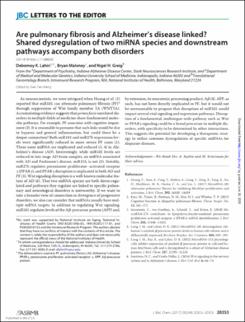Are pulmonary fibrosis and Alzheimer's disease linked? Shared dysregulation of two miRNA species and downstream pathways accompany both disorders

View/
Date
2017-12-08Author
Lahir, Debomoy K.
Maloney, Bryan
Greig, Nigel H.
Metadata
Show full item recordAbstract
As neuroscientists, we were intrigued when Huang et al. (1) reported that miR101 can attenuate pulmonary fibrosis (PF)2 through suppression of Wnt family member 5A (WNT5A). Accumulating evidence suggests that prima facie unrelated disorders in multiple fields of medicine share fundamental molecular pathways. For example, PF associates with cognitive impairment (2). It is reasonable to presume that such links would be due to hypoxia and general inflammation, but could there be a deeper connection? Both miR101 and miR27b expression levels were significantly reduced in more severe PF cases (1). These same miRNA are implicated and reduced (3, 4) in Alzheimer's disease (AD). Interestingly, while miR101 levels are reduced in late-stage AD brain samples, an miRNA associated with AD and Parkinson's disease, miR153, is not (5). Notably, miR27b regulates peroxisome proliferator–activated receptor γ (PPARγ), and PPARγ disruption is implicated in both AD and PF (3). Wnt signaling disruption is a well-known molecular feature of AD (6). That two miRNA species are both down-regulated and pathways they regulate are linked to specific pulmonary and neurological disorders is noteworthy. If we want to take a broader view of connection or divergence of progressive disorders, we also can consider that miRNAs usually have multiple mRNA targets. In addition to regulating Wnt signaling, miR101 regulates levels of the Aβ-precursor protein (APP) and, by extension, its neurotoxic processing product, Aβ (4). APP, as such, has not been directly implicated in PF, but it would not be unreasonable to propose that disruption of miR101 would impact several vital signaling and expression pathways. Disruption of a fundamental, multiorgan-wide pathway such as Wnt or PPARγ signaling could be a broad precursor to multiple disorders, with specificity to be determined by other interactions. This suggests the potential for developing a therapeutic strategy to utilize common dysregulation of specific miRNAs for disparate diseases.
